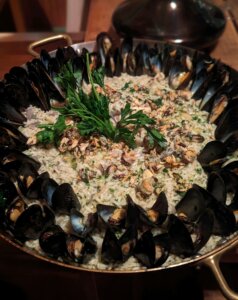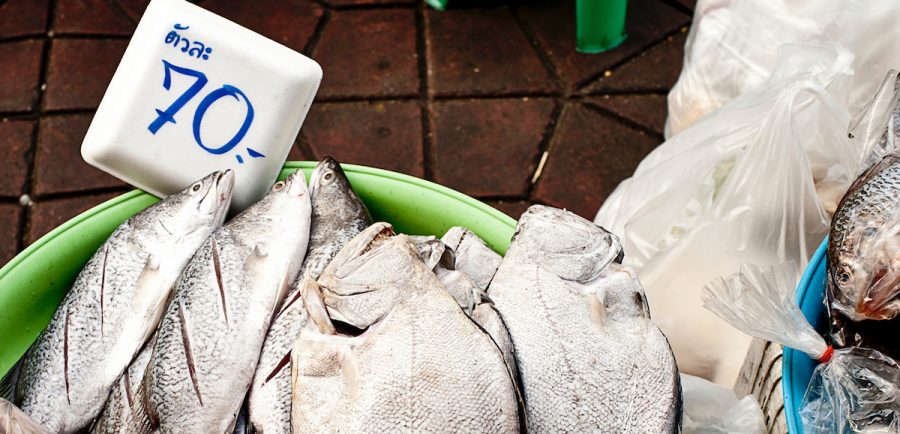Acciughe (Sardines) in umido (option: pasta with sardines)

A plate of sardines, garnished with parsley.
Not too long ago, I cooked sardines for me, my daughter, and a group of her friends. I found the sardines fresh at Whole Foods and bought them because I wanted something tasty, and at the same time healthy, to keep me in shape. The recipe came out great! One of the best dinners I cooked, and everyone loved it.
It takes no time, say 15-20 minutes from start to finish.
Ingredients
- 1 pound sardines (fresh!)
- 4-5 TB olive oil
- 2 cloves of garlic smashed
- 4 teaspoons of finely chopped fresh Italian parsley
- 1 teaspoon of oregano (Italian preferred)
- 3 teaspoons of bread crumbs, plain
- 1 – 2 hot Calabrian, Hawaiian, or Thai pepper
- 15-20 small “pear” tomatoes all colors, each cut into quarters
- ½ glass white wine –Sicilian or Calabrian best, for example Etna Bianco
- Salt to taste
- 1 TB. of capers
Critical element: you need a good pot with a good cover that closes well, no leaks. Ideally a Staub or La Creuset, or a similar heavy pot
Preparation
- Fillet the sardines –if you do not know how, let the fish vendor do it for you, and be sure she also removes the few scales they may have on the skin.
- Cover the bottom of a 6-8 inch pot with 2-3 mm of olive oil, say about ¼ of a cup.
- Add the sardine filets, garlic, 3 teaspoons of parsley (conserve 1 teaspoon for garnish), oregano, hot pepper, tomatoes, bread crumbs, wine, and salt.
- Cover the pot, and then turn on the stove to medium high for about 5 minutes. Stironly once, cover again for 3 more minutes.
- Uncover, and allow to cook another 2 minutes or so, so that the sauce evaporates, and there is no liquid. You know that it is ready when the tomatoes are soft. It should take a total of about 10-12 min.
- Turn off the heat, add 1 TB. of capers and 1 TB. of minced parsley.
- Enjoy!
Option: cook pasta al dente, mix with the sauce you prepared and now you will eat pasta (linguine is the best choice of pastas) with sardines.
Yes, of course, you could prepare the same recipe of sardines in the oven, but my oven is broken, so I cooked them on the fire, and the result was superb!
Italian: Tortino di alici – oppure pasta con alici
–Non molto tempo fa ho cucinato le sarde per me, mia figlia e un gruppo di suoi amici. Ho trovato le sarde fresche da Whole Foods e le ho comprate perché volevo qualcosa di gustoso, e allo stesso tempo sano, che mi tenesse in forma. La ricetta è venuta alla grande!
È delle migliori cene che ho cucinato e è piaciuto a tutti.
Non ci vuole tempo, diciamo 15-20 minuti dall’inizio alla fine.
Ingredienti
- 500 g di sardine –appena pescate
- 5 cucchiai d’olio d’oliva buono
- 2 spicchi d’aglio schiacciati
- 4 cucchiai di prezzemolo tritato
- 1 cucchiaio di origano
- 3 cucchiai di pan grattato
- 1 – 2 peperoncini piccanti
- 15-20 pomodorini pachino tagliati in 4
- 120 ml di vino bianco, un Cirò o Etna Bianco ci sta benissimo
- 1 cucchiaio di capperi
Una buona pentola con coperchio emetico (le Staub sono le migliori).
Preparazione
- Filettate le sarde, se non sapete come fare chiedete aiuto al pescivendolo e naturalmente rimuovete le scaglie, se sono grosse.
- Coprite il fondo della pentola con 2 -3 mm di olio d’oliva buono.
- Versate sull’olio i filetti di alici, l’aglio, 3 cucchiai di prezzemolo tritato, 3 – 4 spicchi di aglio schiacciati, l’origano, peperoncino piccante, i pomodorini, pan grattato, vino e (poco) sale.
- Fuoco medio alto, cuocere 5 minuti coperto, mischiare –solo una volta, coprire di nuovo per 5 minuti. E se c’è troppo liquido –perché avete messo troppo vino- cuocere 2 minuti scoperchiato. È pronto quando i pomodori sono appassiti. In tutto 10-12 minuti massimo.
- Spegnere il fuoco e aggiungere un cucchiaio di prezzemolo tritato e un cucchiaio (o due se vi piacciono tanto) di capperi.
- Buon appetito!
Opzione: Cucinare le linguine al dente e condire con il tortino di alici.
Naturalmente potete farlo al forno, ma il mio forno era rotto e perciò l’ho fatta sui fornelli: è venuta così buona che non ho mai avuto il coraggio di provare a farla al forno!












